Viewing search results for "University of North Carolina at Charlotte"
View All Posts
Mascots are a complicated phenomenon. They inspire a spectrum of reactions: ridicule, ambivalence, or fierce loyalty. With thousands of yearbooks online, all of us here at the Digital Heritage Center have probably spent more time looking at yearbooks than anyone else you’re likely to meet. Mascots are a common theme.
I’ve been working on today’s post for quite some time; unable to find a history or comprehensive list of mascots in North Carolina I decided to compile one myself. So here’s a stab at a college mascot overview, drawn from yearbooks and other campus publications. Let me know what I’ve missed or gotten wrong!
Children
In the early 20th century, schools frequently chose children as mascots or sponsors, whether for a sports team or for a particular class. The earliest example we’ve found on DigitalNC is from a 1910 publication by Atlantic Christian College (now Barton College) in Wilson, which shows Elizabeth Settle Caldwell as the Senior Class sponsor.
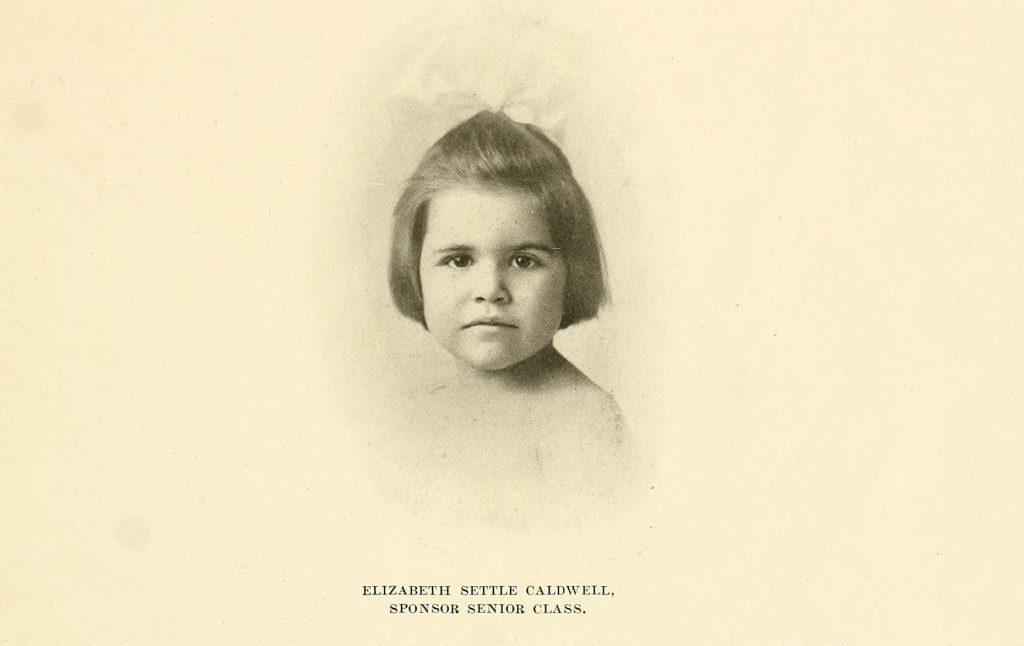
Elizabeth Settle Caldwell, First North Carolina Mascot? From the 1910 Pine Knot yearbook, Atlantic Christian College.
Ms. Caldwell was the daughter of Jesse Cobb Caldwell, the college president. From what we’ve been able to tell, children mascots were frequently younger siblings of students, teachers, or others associated with the school. Students mention that Ms. Caldwell brought “solace to many a lonely, homesick heart” and this may be why children were chosen – to foster a feeling of family and comfort among students. We’ve seen several references to mascots being elected or being chosen through competition, although what this might be we haven’t been able to discover. The trend of choosing children as mascots seems to continue through the 1960s. The latest one we found is Dawn, the Senior Class mascot at Peace College (now William Peace University) in 1966.
Animals
Animal mascots span schools across the state, whether it’s Rameses at UNC-Chapel Hill or WCU’s Catamount. The bulldog and different types of cats win out as most frequently adopted. Pictures of live animal mascots start to appear in yearbooks in the early 1900s, and continue today although much less frequently. For a variety of reasons, including concerns expressed by animal rights activists, schools have shifted away from actual animals to students dressing up like animals, as you’ll see later on in this post.
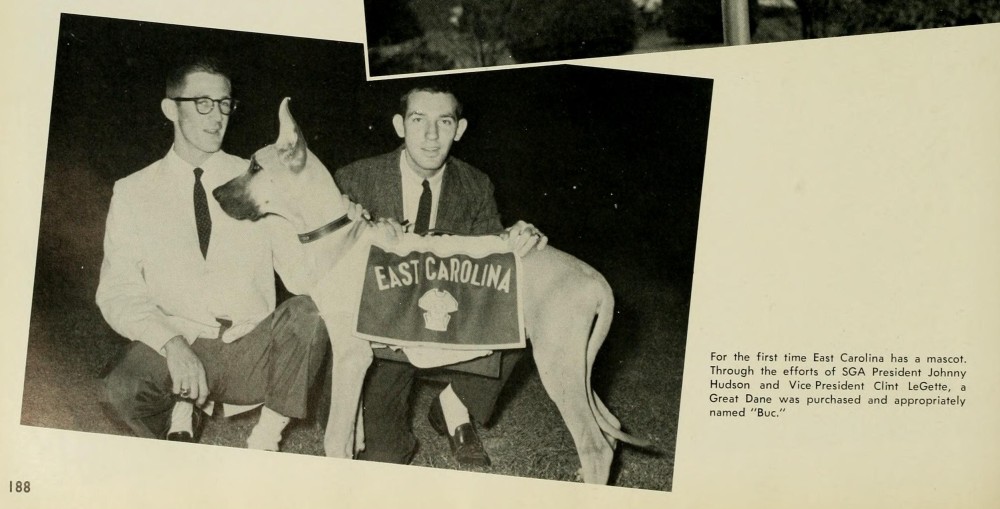
“Buc” is described here as East Carolina University’s first mascot. From the 1959 Buccaneer yearbook.
Characters
While about half of the four-year college mascots in North Carolina are animals, most of the others are characters that are historic, mythical, or extraordinary in nature. From what I’ve seen in NC yearbooks, humans dressing up as the school mascot really got traction in the 1960s. Initially, these costumes weren’t the fuzzy creations we think of today, but rather less complicated ensembles where the mascot’s identity (his or her face and body) was often apparent. Yosef the Mountaineer, beloved icon of Appalachian State University, was created sometime around 1942 and looked like this in the 1960s:
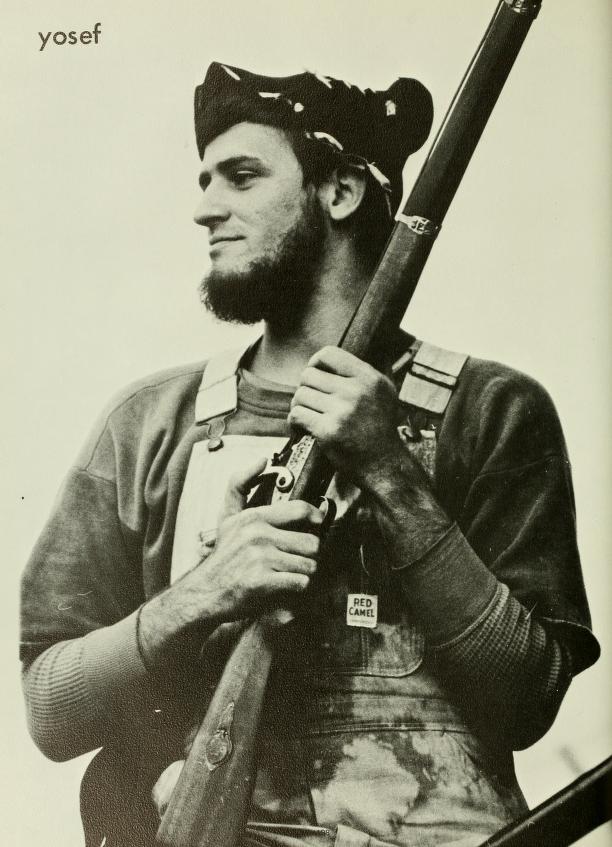
Yosef the Mountaineer, aka James Randle Tedder (we think). From the 1969 Rhododendron yearbook, Appalachian State University.
One of my favorites has to be this picture of Duke Blue Devil, from 1950:
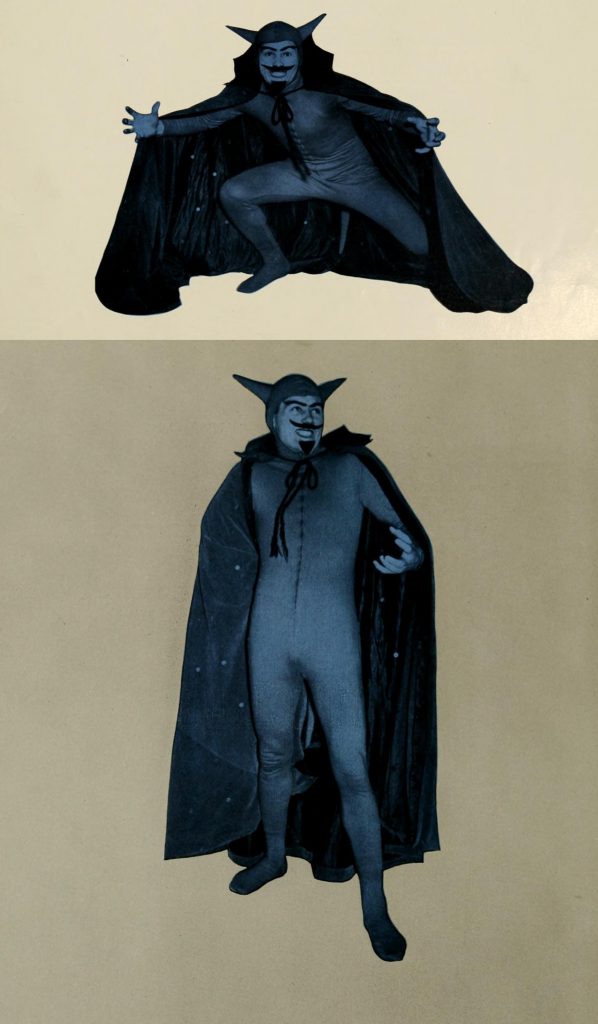
The Blue Devil. From the 1950 Chanticleer yearbook, Duke University.
Perhaps it was too hard to maintain a degree of consistency as students graduated over the years, and mascot anonymity seemed like a better idea. Whatever the reason, you start to see fuzzy, oversized costumes with gigantic headpieces in the late 1970s.
The Big Costumes
Whether animal or character, plush mascots that include a single piece body suit with a large plastic or cloth-covered head is something most Americans can identify with, thanks to professional sports. Colleges in North Carolina really embraced these costumes through the 1980s. Here’s what the UNC-Wilmington Seahawk looked like in 1987:

The Seahawk. From the 1987 Fledgling yearbook, UNC-Wilmington.
Some schools have developed multiple mascots dedicated to different audiences. It seems like the difficulty with these types of costumes is how to pull off a fierce facial expression that doesn’t come off as goofy or too scary for children. I think this picture from Davidson College sums it all up:
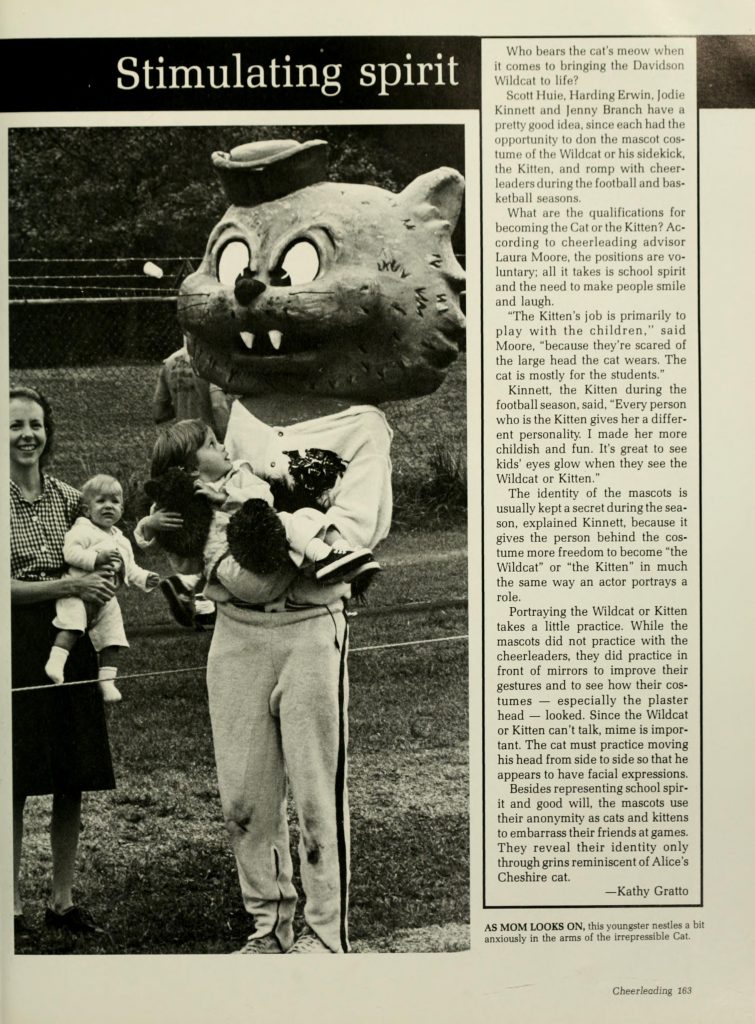
The Davidson Wildcat and … friends. From the 1983 Quips and Cranks yearbook.
I will also take this opportunity to mention a mascot that routinely makes the “wait … what?” list – the Campbell University Fighting Camels:
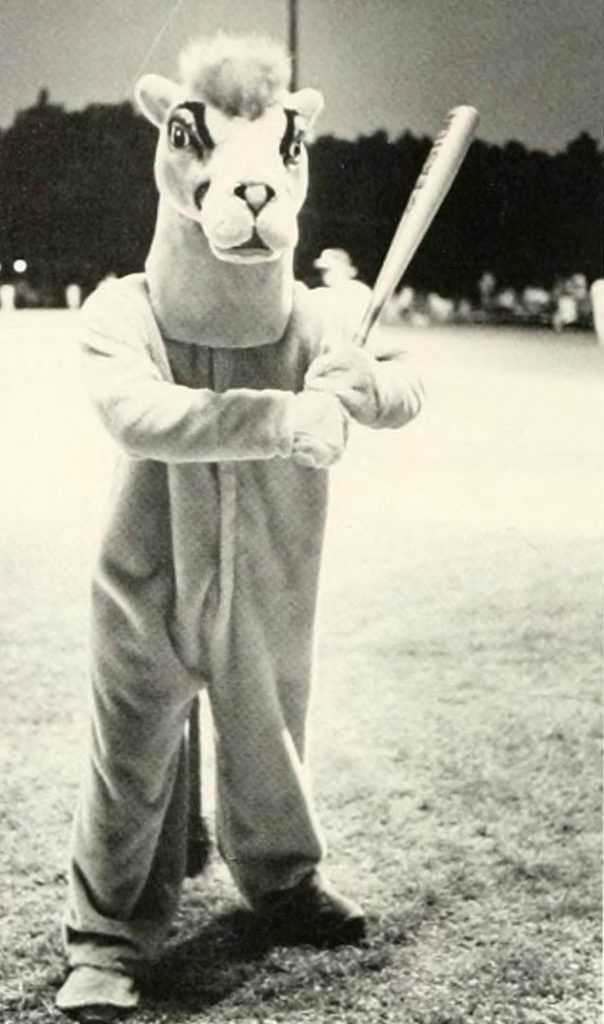
The Campbell Camel. From the 1983 Pine Burr yearbook.
Even the humans and human-like creatures are clothed in oversized costumes these days. Wake Forest University’s Deacon is a dapper chap:
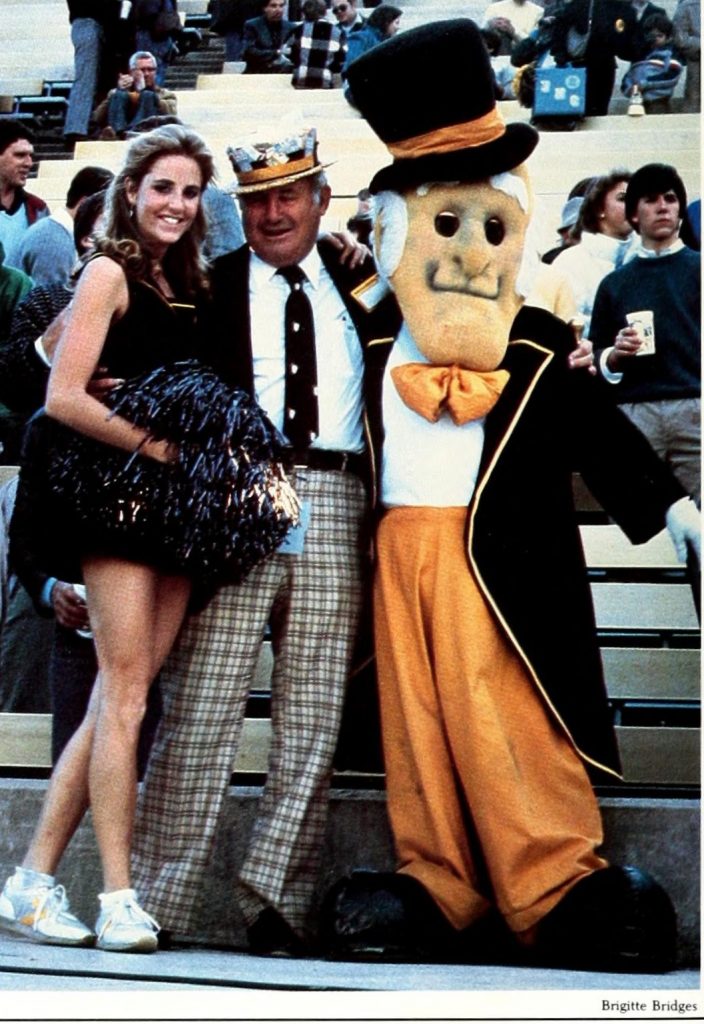
Wake Forest’s Deacon poses with fans. From the 1985 Howler yearbook.
In addition to the Demon Deacons and the Blue Devils, North Carolina boasts a number of other spiritual mascots: North Carolina Wesleyan’s Battling Bishops, Belmont Abbey’s Crusaders, and Guilford College’s Quakers. Meredith College’s teams are known as the Avenging Angels (formerly just the Angels). While Elon University’s mascot is now the Phoenix, before 2000 they were the Fighting Christians:
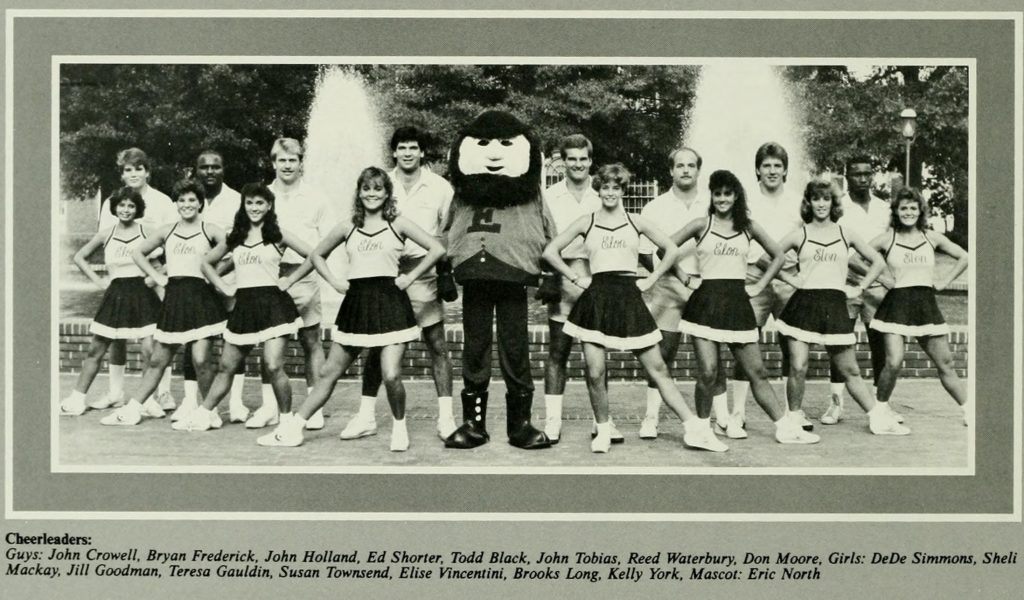
The Elon Fighting Christian mascot with cheerleaders. From the 1986 Phi Psi Cli yearbook.
Two schools break with the animal/human tradition in North Carolina. The Brevard College Tornadoes and the Louisburg College Hurricanes. Weather phenomena mascots are always difficult to pull off. I couldn’t find one for Brevard, but Louisburg, which currently has a bird mascot, had “Louie” up until 2006:
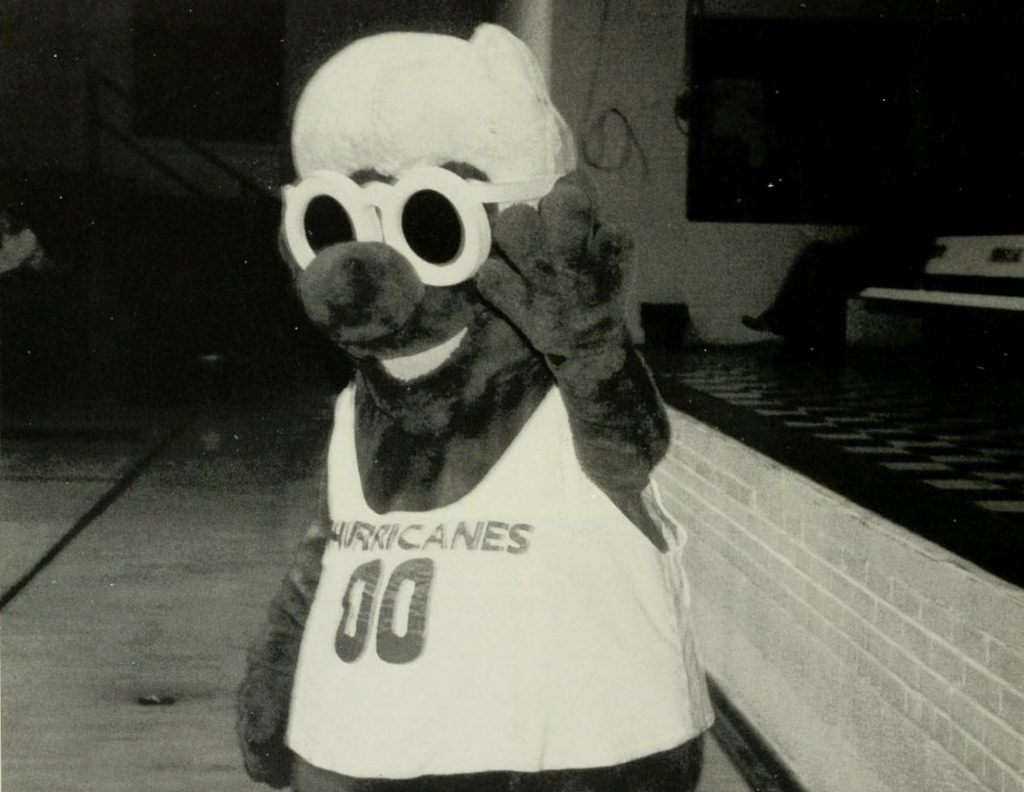
Louie, the former Louisburg College Hurricanes mascot. From the 1996 The Oak yearbook.
Who knows when the next mascot sea change will happen. Below is a list of mascots in North Carolina; let us know if we got anything wrong. Which one is your favorite?
| School |
Mascot |
Notes |
| Appalachian State University |
Yosef the Mountaineer |
First appeared in the yearbook in 1942 |
| Barton College |
Bulldog |
|
| Belmont Abbey College |
Crusader |
|
| Bennett College |
|
Known as the Bennett Belles |
| Brevard College |
Tornado |
|
| Campbell University |
Fighting Camels |
The Hornets in the 1920s-1930s |
| Catawba College |
Catawba Indian |
|
| Chowan University |
Hawks |
The Braves until 2006 |
| Davidson College |
Wildcats |
Also a bulldog (1929) and a bobcat (1939) |
| Duke University |
Blue Devil |
|
| East Carolina University |
Pirates |
Formerly Pee Dee the Pirate |
| Elizabeth City State University |
Vikings |
|
| Elon University |
Phoenix |
The Fightin’ Christians until 2000 |
| Fayetteville State University |
Broncos |
|
| Gardner-Webb University |
Runnin’ Bulldogs |
|
| Greensboro College |
The Pride |
Formerly the Hornets |
| Guilford College |
Quakers |
|
| High Point University |
Panthers |
|
| Johnson C. Smith University |
Golden Bulls |
|
| Lees-McRae College |
Wily the Bobcat |
|
| Lenoir-Rhyne University |
Joe and Josie Bear |
|
| Louisburg College |
Hurricanes |
|
| Mars Hill College |
Mountain Lion |
|
| Meredith College |
Avenging Angels |
Formerly the Angels |
| Methodist University |
Eagles |
|
| Montreat College |
Cavaliers |
|
| Mount Olive College |
Trojans |
|
| North Carolina A&T |
Aggie Dog (Bulldog) |
|
| North Carolina Central University |
Eagles |
|
| North Carolina State University |
Wolfpack |
|
| North Carolina Wesleyan College |
Battling Bishops |
Formerly the Circuit Riders |
| Peace College |
Pacer |
|
| Pfeiffer University |
Falcons |
|
| Queens University of Charlotte |
Rex the Royal |
|
| Saint Augustine’s University |
Mighty Falcons |
|
| Salem College |
Spirits |
|
| Shaw University |
Bears |
|
| St. Andrews University |
Knights |
|
| UNC Asheville |
Bulldog |
|
| UNC Chapel Hill |
Rameses the Ram |
Also known as the Tar Heels |
| UNC Charlotte |
Norm the Niner |
|
| UNC Greensboro |
Spartans |
|
| UNC Pembroke |
Braves |
|
| UNC Wilmington |
Seahawk |
|
| UNC School of the Arts |
Fighting Pickle |
|
| UNC School of Science and Math |
Unicorn |
|
| Wake Forest University |
Demon Deacons |
|
| Warren Wilson College |
Owls |
|
| Western Carolina University |
Catamount |
“Paws” |
| Wingate University |
Bulldog |
|
| Winston-Salem State University |
Ram |
|
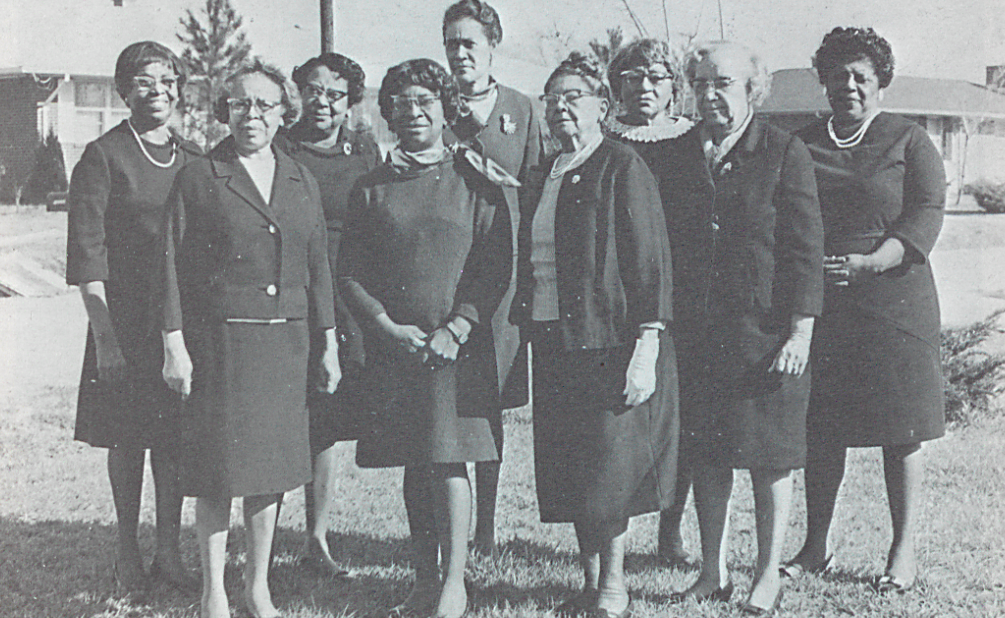
Sixtieth Anniversary Convention of the North Carolina Federation of Negro Women’s Clubs, Page 27
Thanks to our partners at North Carolina Central University, DigitalNC has published a large batch of materials from the North Carolina Federation of Negro Women’s Clubs.
Founded in 1909 by Dr. Charlotte Hawkins Brown, the North Carolina Federation of Negro Women Clubs, Young Adult & Youth Clubs, Incorporated is a social service organization focused on issues that affect women, children, and communities of color in North Carolina. The group still meets regularly and many of the materials date from the most recent conference. This exhibit contains materials relating the organization’s statewide activities, including conferences, fundraisers, and service activities.
The group’s motto, “Lifting as we climb,” helps to illustrate the philosophy that drove the generations of women who participated in the Federation’s various clubs throughout the state. Members fostered the importance and value of human life and the constant desire for acceptance and worth. The issues that are closest to the heart of the NC Federation include fundraising for educational scholarships, providing Braille resources for people who are blind, raising awareness for sickle cell disease and HIV-AIDS, advocating for children, youth and senior citizens, and supporting the NAACP.

Constitution and By-Laws of North Carolina Federation of Negro Women’s Clubs, Young Adult and Youth Clubs, Inc.; Page 1
These items, collected in a new exhibit, document more than 60 years of the organization’s existence. The batch includes several conference programs, highlighting the activities and people who embodied the “Lifting as We Climb” motto. Several highlights from this collection are listed at the links below:
To learn more about North Carolina Central University and to see all of their contributions to the site, please visit their contributor page or the website. To see more items like these, browse the North Carolina Memory Collection or the North Carolina Newspaper Collection.
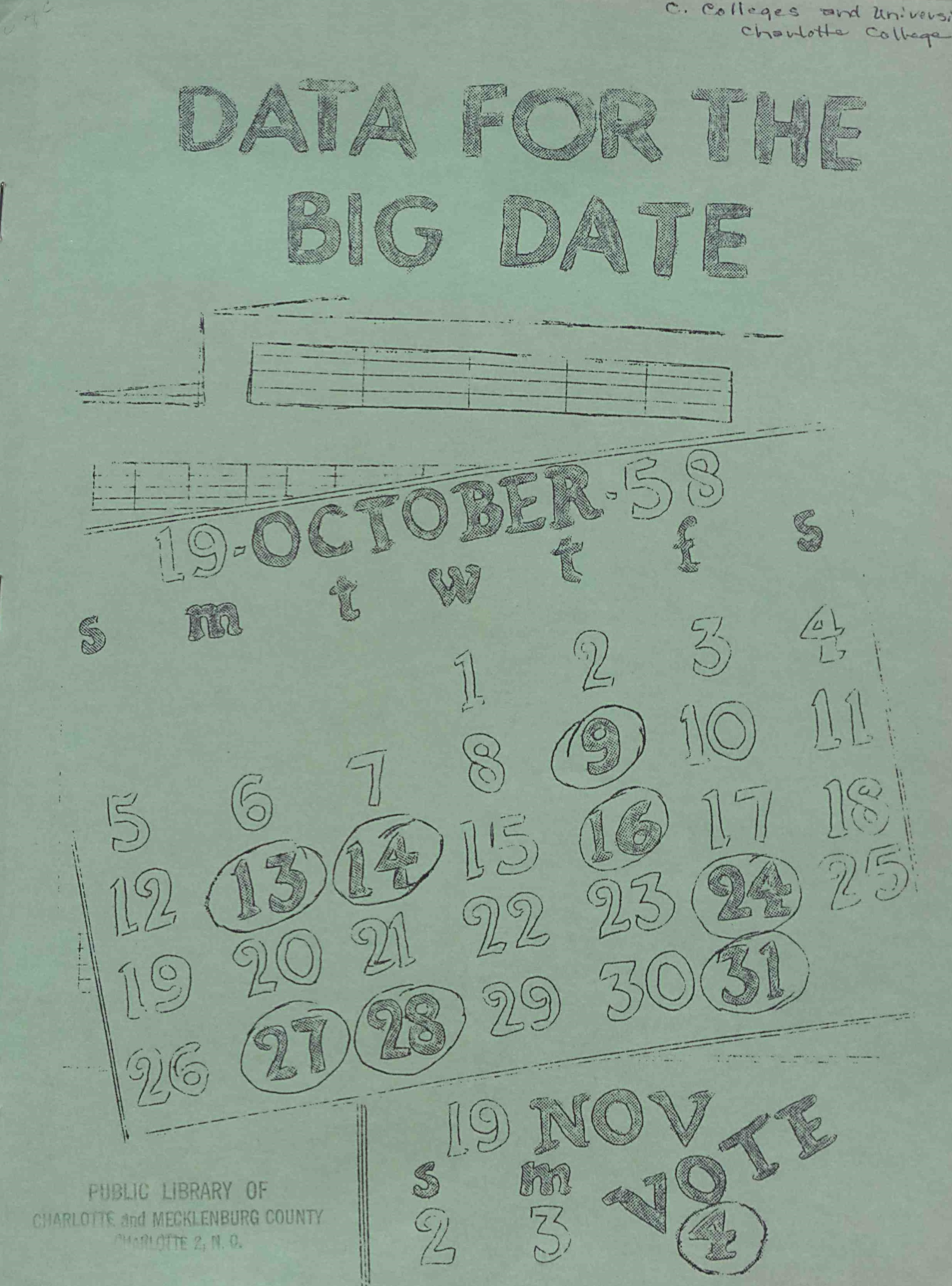
Data for the Big Date, cover
Several new items from Charlotte Mecklenburg Library are now available online. These items tell the story of two Queen City community colleges and the social issues surrounding them– specifically Carver College and Charlotte College.
The materials in this batch document the conversation surrounding several bond elections held in Charlotte in the late 1950’s to the early 1960’s. These bond elections centered on a debate about whether Charlotte should have two community colleges– one for white students and one for Black students. The report “Should Charlotte Build Two Community Colleges?” summarizes the arguments on both sides and gives a detailed narrative about how various stakeholders in the education community responded to social changes in North Carolina during the 1960’s.
These items could be excellent primary source documents for educators constructing curriculum about the civil rights movement in North Carolina.
View all of the new documents at the links below:
You can see more information about Carver College by browsing their materials in the North Carolina Yearbooks Collection. You can learn more about the Charlotte Mecklenburg Library by visiting their contributor page or their website.
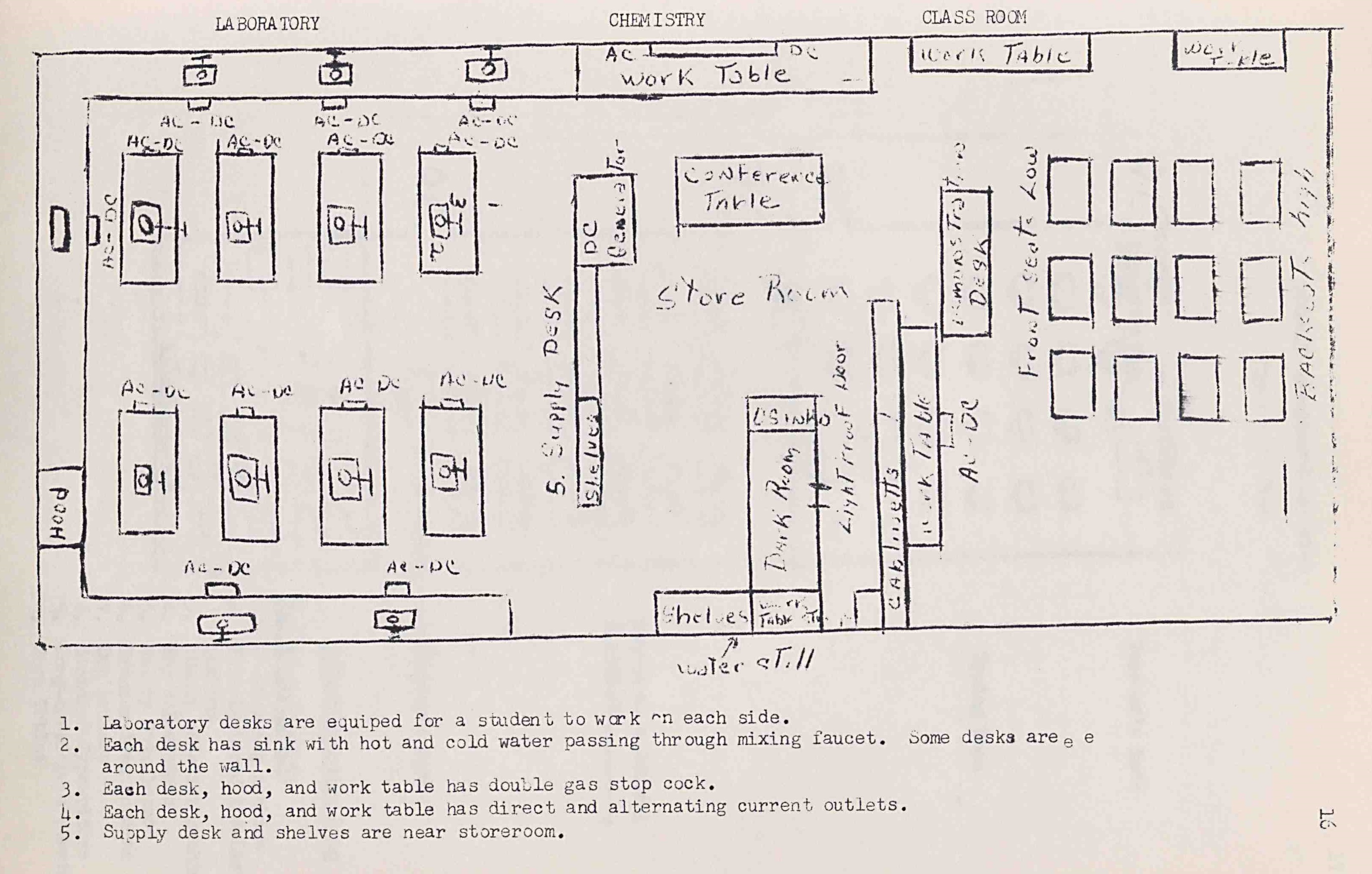
Information on Carver College, page 17
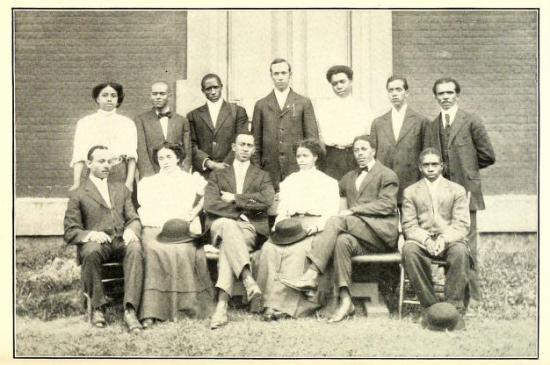
Students at Shaw University, 1911.
With the recent addition of student yearbooks from Livingstone College, DigitalNC now hosts historic materials from ten different Historically Black Colleges and Universities in North Carolina. These materials document more than a century of African American higher education in North Carolina. From our earliest projects in 2010 to the present, the North Carolina Digital Heritage Center has worked closely with libraries and archives at historically Black colleges around the state, and we continue to add materials from these collections on a regular basis. Follow the links below to browse yearbooks, newspapers, photos, scrapbooks, and more materials by school.
Bennett College (Greensboro)
Elizabeth City State University
Fayetteville State University
Johnson C. Smith University (Charlotte)
Livingstone College (Salisbury)
North Carolina A&T (Greensboro)
North Carolina Central University (Durham)
Saint Augustine’s University (Raleigh)
Shaw University (Raleigh)
Winston-Salem State University
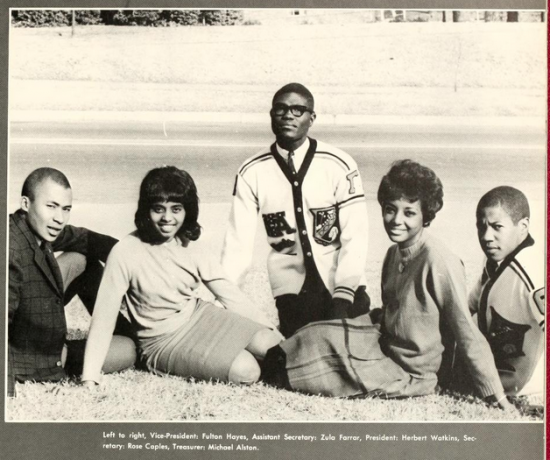
Sophomore class officers at North Carolina Central University, 1963.
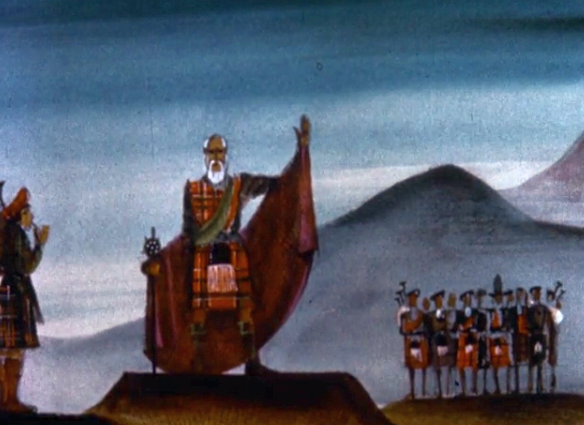
Film still from The Road to Carolina
In the early 1960s, North Carolina’s state government created a Film Board to “portray and illuminate the people, problems, themes, and life of the State” (Oettinger 1964/1965, p. 1). Championed by Governor Terry Sanford, the Board operated from 1962-1965 and created 19 films. As part of our recent audio-visual project, the Charlotte Mecklenburg Library and the North Carolina Collection at UNC-Chapel Hill’s Wilson Library contributed eight of these films for digitization.
During the Board’s operation, “ideas and requests for the films came from various state departments, individuals on the Governor’s staff or historical associations from around the state” (Ferrara 1981, p. 23). Production costs for each film averaged $30,000. James Beveridge, a filmmaker from Canada, was brought in to head the Board. (The State Archives has shared film clips from Beveridge online as well.)
The Board aimed to produce films that were documentary in nature, looking at different industries, locations, or segments of the population. Some addressed politically charged issues; the Minority Report series is a stark exploration of race relations. “Goodbye to Carolina,” was coordinated with the help of the Intercollegiate Council for Human Rights, chaired by then A&T student Jesse Jackson.
Below is a list of the films produced by the Board that are currently available on DigitalNC*:
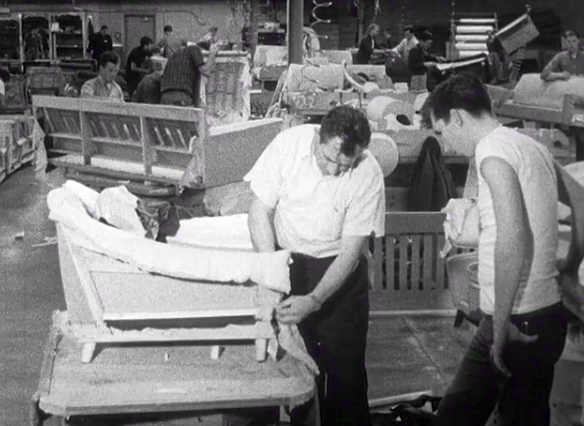
Film still from Welcome to Work
- The Ayes Have It (1963) A behind-the-scenes look at the North Carolina General Assembly.
- Minority Report: A Series Stating the Opinions and Experiences of Negro Students in North Carolina
- Goodbye to Carolina (1964) Interviews with North Carolina A&T College (now University) about their reasons for seeking jobs outside of North Carolina.
- A Knocking at the Gate (1964) Interviews with North Carolina College (now North Carolina Central University) students about civil rights.
- North Carolina’s Tribute to President John F. Kennedy (1964) Covers the memorial ceremonies for the late President held at UNC-Chapel Hill.
- The Road to Carolina (1963) Commissioned by the NC Tercentenary Commission and created for eight graders, this illustrated film recounts the first hundred years of the state’s colonial history.
- The Search for Excellence (1965) Follows rural residents’ experiences as communities around the state were consolidating educational resources and schools to a centralized model.
- The Vanishing Frontier (1963) The state’s Appalachian communities are documented through first-hand accounts with citizens, revealing the area’s “poverty and promise” (Ferrara, p. 28).
- Welcome to Work: The Siler City Story (1964) Describes the changes in Siler City as it transitioned from an agricultural-based to an industrial-based economy.
- Updated March 21, 2019
It’s interesting to see the film topics chosen during this time period. Instead of shying away from hot button issues or glossing over the widespread demographic, economic, and social changes of the era, the Film Board tackled them with a freer hand than might be expected. Such ambitious and frank efforts eventually contributed to the Board’s dissolution.
You can view additional items on DigitalNC from the Charlotte Mecklenburg Library and the University of North Carolina at Chapel Hill.
Notes
*The other films are: Land of Beginnings; Minority Report: Vote and the Choice is Yours; Minority Report: We’re Not Alone; Nine Months To Go; The Outer Banks (possibly lost, according to Ferrara)
References
Ferrara, Susan E. “The Demise of the North Carolina Film Board: Public Policy Implications.” M.A. thesis., University of North Carolina at Chapel Hill, 1981.
Oettinger, Elmer. “The North Carolina Film Board: A Unique Program in Documentary and Educational Film Making.” The Journal of the Society of Cinematologists 4/5 (1964/1965): p. 55-65.
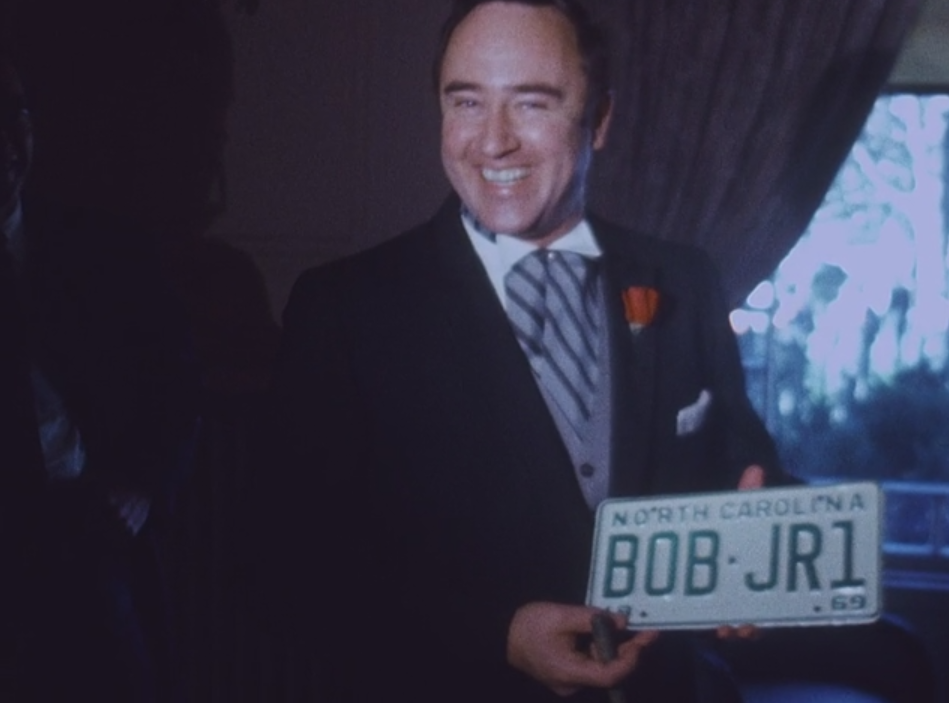
Governor Robert W. Scott receives a “Bob Jr.” license plate in this footage of his inauguration and subsequent celebrations. Contributed by the State Archives of North Carolina.
Almost one year ago, we asked our partners for nominations of audio and video media from their collections to digitize, using funding from the Digital Public Library of America. From all corners of North Carolina came suggestions for moving images and sound. Some items were well documented, with descriptions or finding aids [?] in tow. Others were accompanied with the words “We think this is … but we really have no idea.” Thanks to George Blood, L. P., who digitized these items for us, and Andrea Green, our former Community Digitization Manager, we ended up with over 140 physical items digitized from 11 institutions.
Here’s an overview of what’s been added to DigitalNC to our new Sights and Sounds collection (some of our partners will be posting their digitized media on their own digital collection sites instead). Stay tuned over the next few weeks for more posts taking a closer look at some of our favorites.
Braswell Memorial Library
Throughout the 1990s, Mary Lewis Deans spearheaded an ambitious and well-documented oral history campaign in Nash County. She and her colleagues spoke with long-time residents about rural farming life, military service during World War II, segregation, and family traditions. Deans was businesslike yet friendly, no-nonsense and yet genuine. Listen to and read Deans’ oral histories.
Charlotte Mecklenburg Library
Three of the films contributed by Charlotte Mecklenburg Library help document the history of Charlotte. The Charlotte Mecklenburg United Appeal campaign from 1952 shows numerous Charlotte places.
Davie County Public Library
From Davie County Public Library comes a two-part series on Davie County History, and a home video of local personality Louise Graham Stroud, who performed monologues as her self-created character, “Miss Lizzie.”
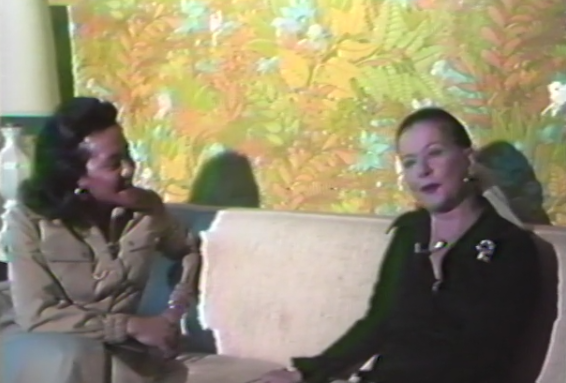
Cynthia Watts (left) interviews actress Joan Bennett in one of the Arts in Durham films contributed by the Durham Public Library.
Durham Public Library
Love Durham? Love the Arts? Love the late 70s? Some of our staff favorites come from Durham Public Library’s collection of “Arts in Durham” films. Produced by the Durham Arts Council, these films showcase local bands, dance groups, visual artists, and more. We’ll definitely be blogging about our favorite moments. Durham Public Library also contributed a taped lecture by Dr. Charles Watts on the history of Lincoln Hospital, and two-part coverage of the Durham County Centennial Parade of 1981.
Edgecombe Memorial Library
Tobacco Perspectives is an amateur recording of a two-night event in the early 1980s during which a historian, a political scientist, and representatives from farm, industry, and public health agencies lectured on the tobacco industry both past and present.
Rockingham County Public Library
We’ve already announced the bookmobile film from Rockingham County, but we’re still looking for someone who can identify the school that’s shown. In this film boys and girls eagerly peruse and check out books from local librarians. It’s even got Jim, the library dog.
State Archives of North Carolina
We were pleased to join for the first time with the State Archives during this project, as they chose a number of films that document the state’s history. Among the films from the Archives that we’ve added online are coverage of Governor R. W. Scott II’s inauguration and U. S. Coast Guard Appreciation Day (1970).
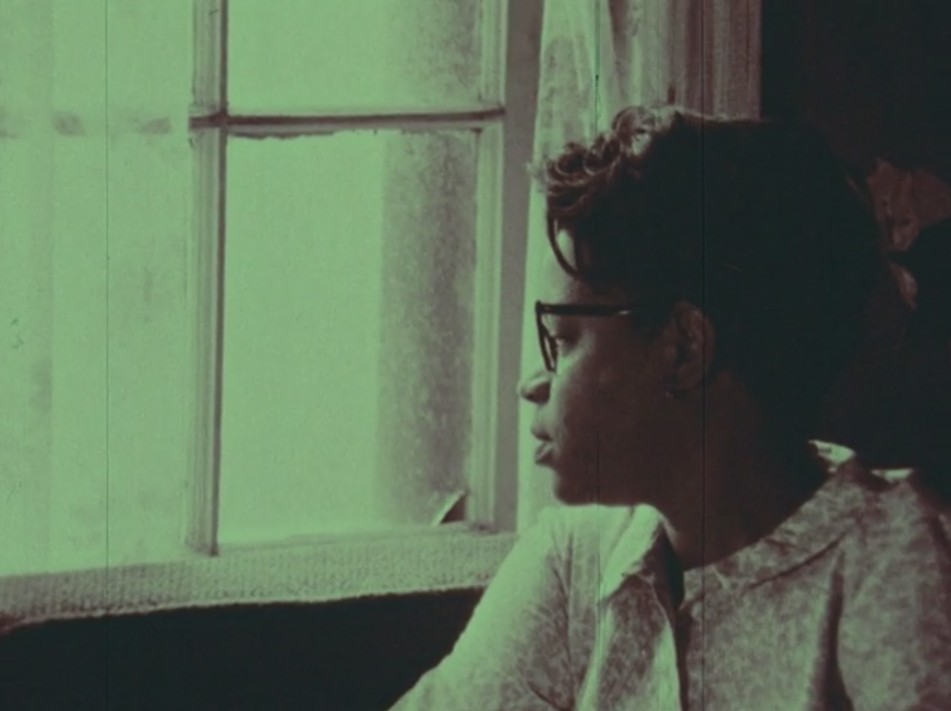
No Handouts for Mrs. Hedgepeth, 1968, documented a Durham family living below the poverty line. Contributed by the North Carolina Collection, UNC-Chapel Hill.
University of North Carolina at Chapel Hill
From 1962-1965, the North Carolina Film Board produced films tackling some of the most pressing issues in North Carolina: race relations, education, and economic opportunity. Eight of those films join others from the North Carolina Collection and Southern Historical Collection at UNC-Chapel Hill on DigitalNC. As might be expected, some are about UNC and Chapel Hill. Fans of the Hugh Morton Collection will also see several films believed to have been filmed by Morton or his colleagues. There’s even footage of Mildred the Bear.
University of North Carolina at Charlotte
In 1960, Dr. Bertha Maxwell-Roddey became the first chair of what is now the Department of Africana Studies at UNC-Charlotte, which contributed three items related to her career. A scholar, educator, and community icon, one of these shows children in a classroom being taught by Maxwell-Roddey’s students. The others show a night of live poetry and music.
We hope you enjoy North Carolina’s Sights and Sounds. Click to view all of the films and oral histories together.
The Charlotte Mecklenburg Library sent us quite a few yearbooks from the early 20th century. The majority come from Presbyterian College for Women (later Queens College and Queens University), Elizabeth College, and Mecklenburg Female College. These yearbooks highlight the friendships built among the young women, as well as their concerns and interests.
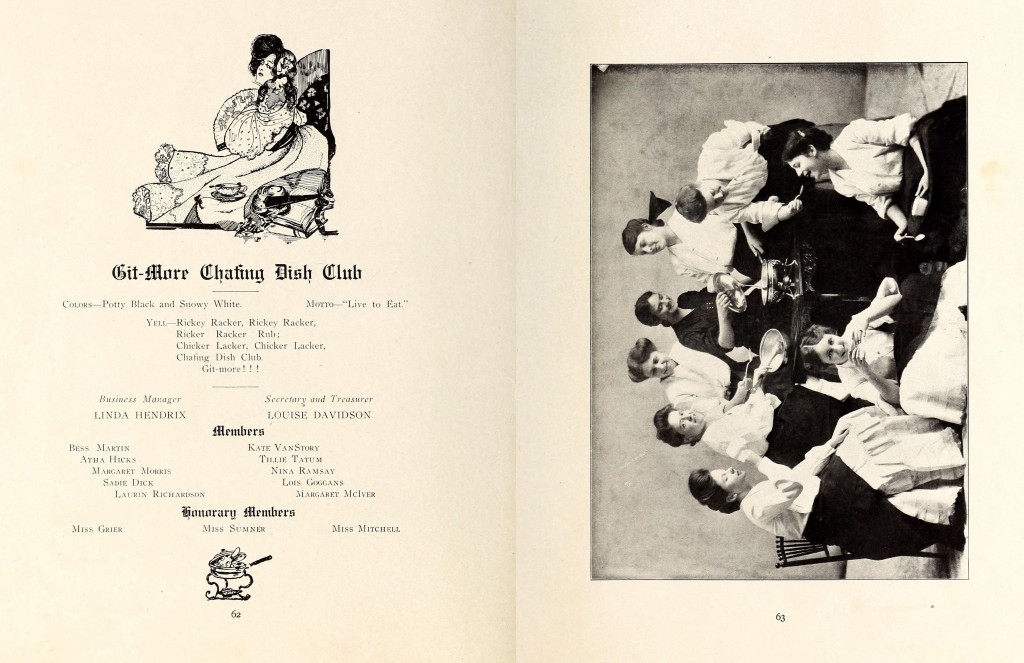
Git-More Chafing Dish Club, Presbyterian College for Women, 1905.
These 21 yearbooks, dating from 1904-1934, come to us from Queens University of Charlotte and its several precursor schools. According to NCpedia, the women’s school in Charlotte was founded in 1857 and known in sequence as: Charlotte Female Institute, Seminary for Girls, Presbyterian College for Women, and Queens College. It merged with the South Carolina school Chicora College in 1930 and was known as Queens-Chicora College for almost a decade. The school began accepting both genders in 1946, and in 2002 became Queens University of Charlotte.
The yearbooks are full of personality, with delightful drawings and quirky clubs. Some favorites: Git-More Chafing Dish Club, Gitchimanito Club (i.e. “get ye a man or two”), The Suffragettes, Old Maids’ Club, Babes in the Wood, Tom Thumb Crowd (for students who measured five feet or less), the Red-Headed Stepchildren, and Witches’ Club. Many volumes also include delightful drawings.
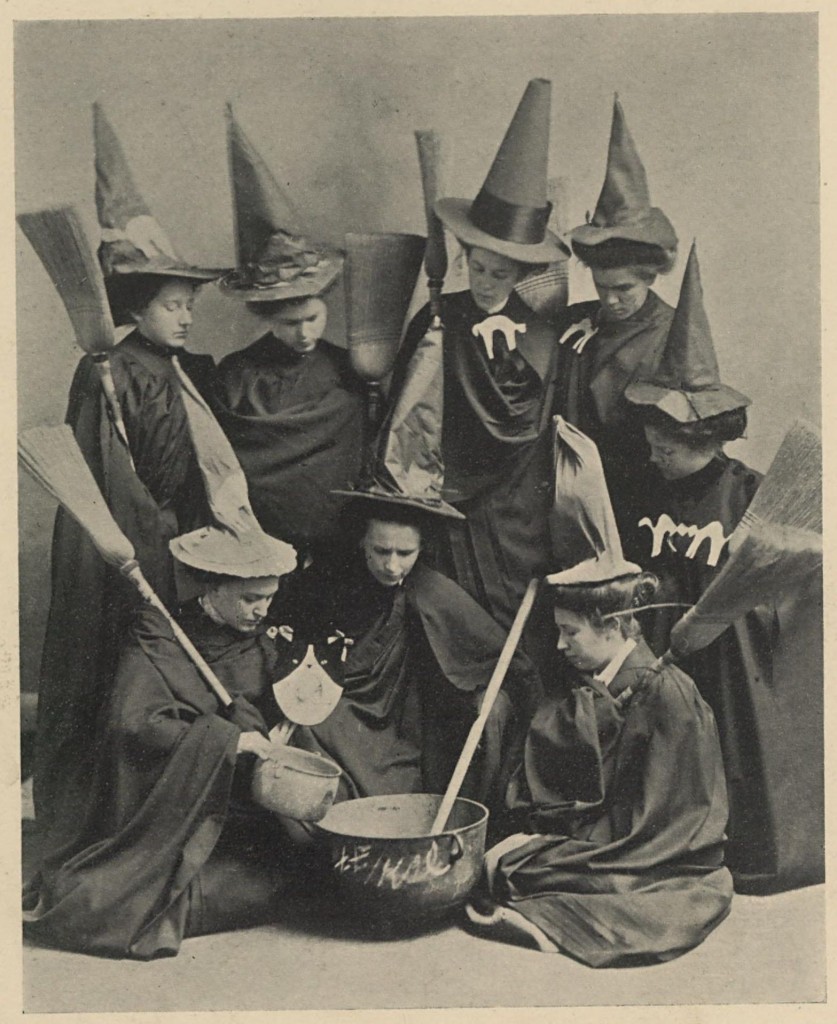
Witches Club, Presbyterian College for Women, 1910.
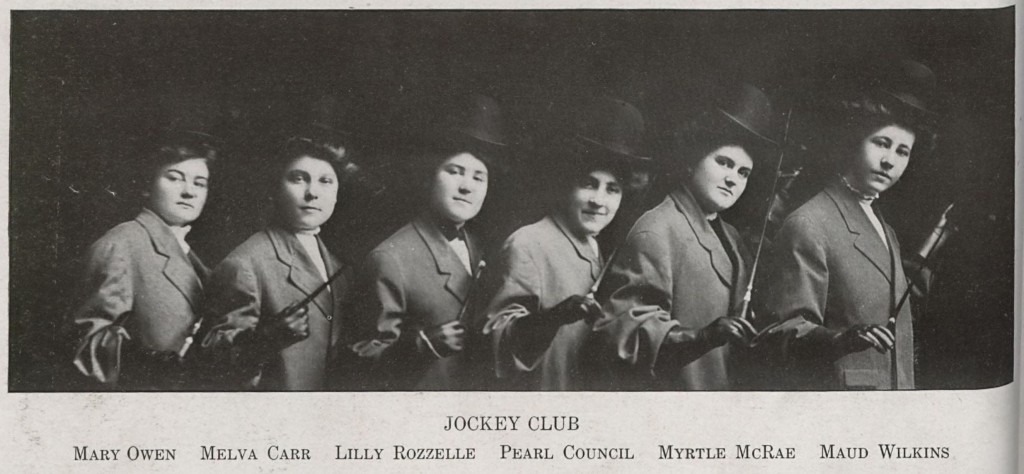
Jockey Club, Presbyterian College for Women, 1908.
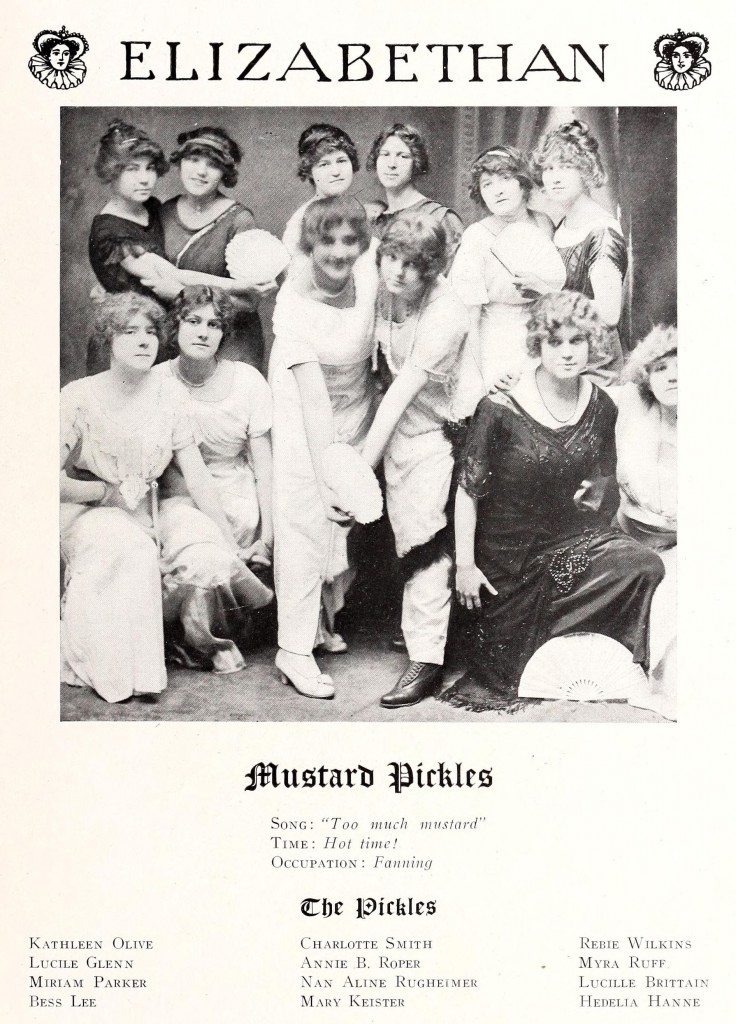
Mustard Pickles, The Elizabethan, Elizabeth College, 1914.
Elizabeth College, founded in 1897, was another early women’s college in the Queen City. The school merged with Roanoke College for Women in 1915 and moved to Salem, Virginia until 1921, when it burned and was never re-established. The Elizabeth College buildings in Charlotte endured, housing Presbyterian Hospital and the School of Nursing until it was torn down in 1980. Two yearbooks, 1914 and 1915, add to the existing eight yearbooks on DigitalNC dating from 1901. These two most recent The Elizabethan yearbooks are as charming as they are informative. Like The Edelweiss volumes from Presbyterian College for Women/Queen’s College, the club descriptions and photographs show the women both playfully and earnestly asserting their personalities, friendships, and interests. Some favorite clubs are Anti-Fat Club, Do As You Please, and Mustard Pickles. There’s also some analysis of how the women of the class of 1914 conformed (or not) to Victorian standards.
- Mecklenburg Female College
This 1868 volume is part yearbook, part literary magazine, as is characteristic of many early campus publications. This 1868 volume is both the first and penultimate volume; the school for women was only in existence for two years. The buildings were rented from the North Carolina Military Institute (later the Carolina Military Institute, also called the Charlotte Military Institute). For more information on the former Mecklenburg Female College, a broadside distributed by the college and digitized by DocSouth is particularly useful.
Several other items were also digitized from Charlotte Mecklenburg Library, including yearbook volumes 1961 and 1963 from King’s College, a small school in Charlotte founded in 1901.
Adding to our high school yearbook collection, East Mecklenburg High School years 1953 and 1954 are now available on DigitalNC. Long Creek High School, 1947 is also available.
The final item from Charlotte Mecklenburg Library is a program from the 16th Women’s History Hall of Fame Induction Ceremony by the Charlotte Club of the National Association of Negro Business and Professional Women’s Clubs, Incorporated. The four inductees were Carolyn A. Flowers, Shirley L. Fulton, Vi A. Lyles, and Joyce D. Waddell. The program also includes a list of all members of the the Women’s History Hall of Fame.
You can view all of the items digitized for Charlotte Mecklenburg Library on DigitalNC here.
Here are our picks for the 7 cleverest North Carolina yearbook titles in our collection.
#7 “Hickory Log” Hickory High School
A clever play on words for this “log” of the year’s activities. View all Hickory High School yearbooks, courtesy the Hickory Public Library.
#6 “The Si Si” University of North Carolina at Charlotte
The University of North Carolina at Charlotte was formerly known as Charlotte College. View all University of North Carolina at Charlotte yearbooks.
#5 “Gray Matter” Wake Forest School of Medicine
There are all kinds of clever covers for this intellectually themed, physiologically fitting title. View all Wake Forest School of Medicine yearbooks.
#4 “Hacawa” Lenoir-Rhyne University
“Hacawa” is a one-word abbreviation of Halls, Campus, Walls. In and around these centers the whole student life here. The Hacawa is an emanation from the work, play, joys, trials, and triumphs of the entire college for the year.” (1909 Hacawa, p. 8) View all Lenoir-Rhyne University yearbooks.
#3 “Quips and Cranks” Davidson College
“Haste thee nymph, and bring with thee
Jest and youthful Jollity,
Quips and cranks, and wanton wiles,
Nods, and becks, and wreathed smiles…” – L’Allegro, by John Milton
View all Davidson College yearbooks
#2 “Wagrub” Burgaw High School
We like this title because the students capitalized on the school name they were dealt. View all Burgaw High School yearbooks, courtesy the Pender County Public Library.
#1 “Ayantee” North Carolina Agricultural and Technical State University
You may need to say our the title out loud before it sinks in. This one has stumped staff in the past, making it our #1 pick. View all North Carolina Agricultural and Technical State University yearbooks.
Disagree with our picks? Let us know.
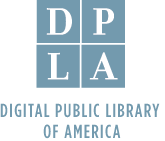 Elon University, Pender County Public Library, and UNC-Charlotte are the three newest North Carolina institutions to join the Digital Public Library of America. North Carolina institutions are now represented with almost 160,000 digital items.
Elon University, Pender County Public Library, and UNC-Charlotte are the three newest North Carolina institutions to join the Digital Public Library of America. North Carolina institutions are now represented with almost 160,000 digital items.
The North Carolina Digital Heritage Center is the DPLA’s hub in North Carolina. You can read more about the DPLA and North Carolina in an earlier blog post from the official launch last month.
Big news for alumni of public universities in North Carolina: student yearbooks from all 15 University of North Carolina system universities are now freely available online. Yearbooks for 14 of the schools have been digitized by the North Carolina Digital Heritage Center and are available in the North Carolina Yearbooks collection on DigitalNC, while yearbooks from North Carolina State University are available through the excellent Historical State digital collection.
These yearbooks are terrific resources for students and alumni, as well as anyone interested in the evolution of higher education and student life in 20th-century North Carolina. There are a total of 774 volumes available from these schools, ranging in date from 1890 (
The Hellenian, at UNC-Chapel Hill) to the present.
Pick your alma mater or hometown school from the links below and start browsing:

























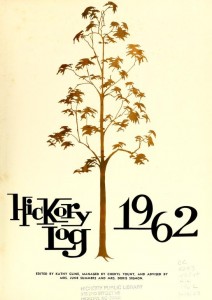
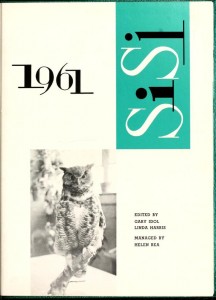
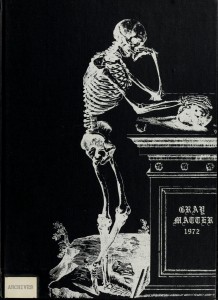
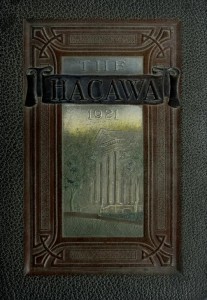
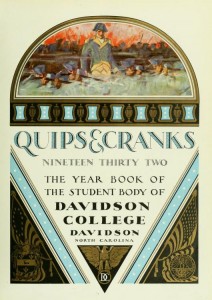
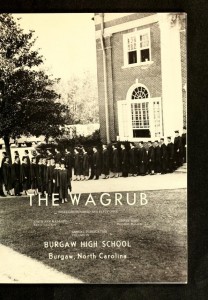
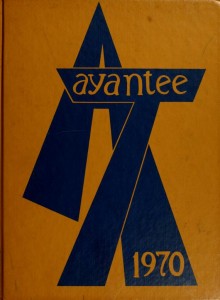
 Elon University
Elon University
